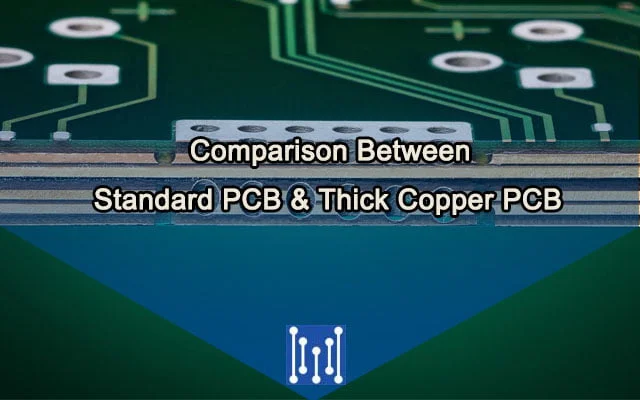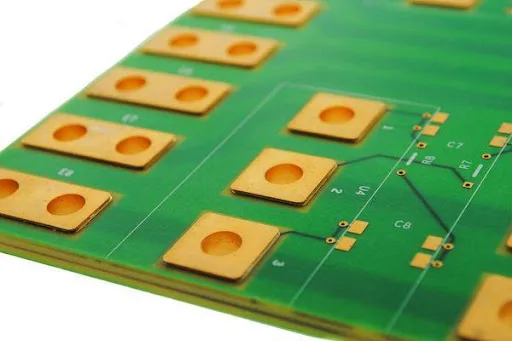In the world of modern electronics, home appliances are becoming more powerful and complex, demanding circuit boards that can handle high currents and extreme conditions. This is where heavy copper PCBs come into play. These specialized printed circuit boards are designed to manage significant power loads and maintain reliability in high-demand applications. If you're wondering how heavy copper PCBs can enhance the performance of home appliances, this blog will dive deep into their design, manufacturing, benefits, and applications.
Whether you're an engineer designing robust systems or a manufacturer looking to improve appliance durability, this guide covers everything you need to know about heavy copper PCB design guidelines, manufacturing processes, thermal performance, current carrying capacity, and their specific applications in home appliances. Let's explore how these powerful boards are transforming the way we power our homes.
What Are Heavy Copper PCBs and Why Do They Matter?
Heavy copper PCBs are circuit boards that use thicker copper layers compared to standard PCBs. While a typical PCB might have copper layers of 1 to 2 ounces per square foot (oz/ft2), heavy copper PCBs often feature copper weights of 3 oz/ft2 or more, sometimes reaching up to 20 oz/ft2 or beyond in extreme cases. This increased copper thickness allows the board to handle higher currents, dissipate heat more effectively, and withstand harsh conditions without failing.
For home appliances like refrigerators, air conditioners, and washing machines, which often operate under high power and varying temperatures, heavy copper PCBs are a game-changer. They ensure consistent performance, prevent overheating, and extend the lifespan of the appliance, making them a critical component in modern designs.

Heavy Copper PCB Design Guidelines for Optimal Performance
Designing a heavy copper PCB requires careful planning to ensure it meets the needs of high-demand applications. Below are some essential guidelines to follow:
- Copper Weight Selection: Choose the appropriate copper weight based on the current requirements. For instance, a 3 oz/ft2 copper layer can handle around 10-15 amps per trace (depending on width), while 6 oz/ft2 can manage double that capacity. Calculate the expected current load and select accordingly.
- Trace Width and Spacing: Wider traces are necessary to carry higher currents without overheating. Use design tools to calculate trace width based on current and temperature rise limits, often aiming for a temperature rise of no more than 10-20°C above ambient.
- Thermal Vias and Heat Sinks: Incorporate thermal vias to transfer heat away from critical components. Pairing these with heat sinks can further improve thermal management, especially in appliances with power-intensive motors or compressors.
- Layer Stack-Up: Plan the layer stack-up to balance power distribution and signal integrity. Place heavy copper layers strategically to minimize interference with sensitive signal layers.
- Mechanical Strength: Thicker copper enhances the board's durability, especially at connector points and plated-through holes. Reinforce these areas to prevent cracking under stress.
Following these heavy copper PCB design guidelines ensures that the board can handle the rigors of high-power applications while maintaining reliability.

Heavy Copper PCB Manufacturing Process: Building for Durability
The manufacturing process for heavy copper PCBs is more complex than for standard boards due to the thicker copper layers. Here's a step-by-step look at how these robust boards are made:
- Material Selection: High-quality laminate materials that can withstand high temperatures and mechanical stress are chosen. FR-4 is common, but advanced materials may be used for extreme applications.
- Copper Deposition: The process begins with depositing a base layer of copper on the substrate. For heavy copper boards, additional copper is plated onto the traces using electroplating techniques to achieve the desired thickness.
- Etching: Excess copper is etched away to form the circuit pattern. This step requires precision, as thicker copper can be more challenging to etch uniformly.
- Drilling and Plating: Holes for components and vias are drilled, then plated with copper to ensure strong electrical connections. This step is critical for maintaining current carrying capacity.
- Solder Mask and Finishing: A solder mask is applied to protect the board, followed by a surface finish like ENIG (Electroless Nickel Immersion Gold) to prevent oxidation and ensure solderability.
- Testing: Rigorous testing, including electrical and thermal stress tests, ensures the board meets design specifications. For example, boards may be tested to withstand thermal cycles from -40°C to 85°C.
Understanding the heavy copper PCB manufacturing process helps designers anticipate potential challenges, such as uneven copper distribution, and work with manufacturers to achieve the best results.

Heavy Copper PCB Thermal Performance: Keeping Appliances Cool
One of the standout features of heavy copper PCBs is their superior thermal performance. Home appliances often generate significant heat during operation, especially those with motors or heating elements like dryers and microwaves. Here's how heavy copper PCBs manage heat effectively:
- Enhanced Heat Dissipation: Thicker copper layers act as natural heat sinks, spreading heat across the board and away from critical components. This can reduce hotspot temperatures by up to 30% compared to standard PCBs.
- Reduced Thermal Resistance: Copper's high thermal conductivity (around 400 W/m·K) allows heat to move quickly through the board, minimizing thermal resistance and preventing component damage.
- Support for High-Power Components: Components that draw significant power, such as power inverters in air conditioners, benefit from the board's ability to handle thermal stress without degrading.
By prioritizing heavy copper PCB thermal performance, manufacturers can create appliances that run cooler and last longer, even under continuous use.
Heavy Copper PCB Current Carrying Capacity: Powering High Loads
The ability to handle high currents is a defining characteristic of heavy copper PCBs. Standard PCBs often struggle with currents above a few amps, leading to overheating and failure. In contrast, heavy copper PCBs excel in this area:
- Higher Amperage Support: A 4 oz/ft2 copper trace, for example, can carry up to 20-25 amps with a 1-inch width, while a 10 oz/ft2 trace can handle over 50 amps under similar conditions. This makes them ideal for power-intensive appliances.
- Reduced Voltage Drop: Thicker copper minimizes resistance, ensuring that voltage remains stable across the board, even at high currents. This is crucial for maintaining appliance efficiency.
- Customizable Trace Design: Designers can adjust trace thickness and width to match specific current needs, providing flexibility for various appliance designs.
The heavy copper PCB current carrying capacity ensures that appliances like electric ovens or induction cooktops operate safely and efficiently, even when drawing significant power.
Heavy Copper PCB Applications in Home Appliances
Heavy copper PCBs are increasingly common in home appliances due to their ability to handle high power and tough conditions. Here are some specific heavy copper PCB applications in home appliances:
- Refrigerators and Freezers: These appliances rely on compressors that draw significant current. Heavy copper PCBs ensure stable power delivery and prevent overheating in control circuits.
- Air Conditioners: Inverters and motor control units in air conditioners benefit from the high current capacity and thermal management of heavy copper boards, ensuring reliable cooling performance.
- Washing Machines: The motor drivers and power supplies in washing machines often operate under variable loads. Heavy copper PCBs provide the durability needed for long-term use.
- Microwaves and Ovens: High-power heating elements require robust circuit boards to manage current and heat. Heavy copper designs prevent failures during intense operation.
- Power Tools: While not traditional appliances, household power tools like drills and saws often use heavy copper PCBs to support high current motors and maintain safety.
These examples highlight how heavy copper PCB applications in home appliances contribute to better performance and reliability in everyday products.
Benefits of Using Heavy Copper PCBs in Appliances
Choosing heavy copper PCBs for home appliances offers several advantages that directly impact performance and user satisfaction. Here are the key benefits of using heavy copper PCBs in appliances:
- Improved Reliability: Thicker copper layers reduce the risk of trace burnout and board failure, leading to appliances that last longer and require fewer repairs.
- Better Energy Efficiency: Lower resistance in heavy copper traces means less power loss, improving the overall efficiency of the appliance and reducing energy costs.
- Enhanced Safety: Effective thermal management prevents overheating, reducing the risk of fires or component damage in high-power devices.
- Cost-Effective Longevity: While heavy copper PCBs may have a higher upfront cost, their durability and reduced failure rates save money on replacements and maintenance over time.
- Support for Compact Designs: By handling higher currents in smaller spaces, heavy copper PCBs enable manufacturers to create powerful yet compact appliances.
These benefits make heavy copper PCBs a smart choice for manufacturers aiming to deliver high-quality, dependable home appliances.
Designing Reliable Heavy Copper PCBs: Best Practices
Creating reliable heavy copper PCBs requires attention to detail and adherence to best practices. Here are some tips for designing reliable heavy copper PCBs:
- Simulate Thermal and Electrical Performance: Use simulation software to model current flow and heat distribution before manufacturing. This helps identify potential weak points early in the design process.
- Account for Manufacturing Tolerances: Work closely with your fabrication partner to understand their capabilities and limitations with heavy copper. For instance, ensure they can achieve uniform copper thickness across the board.
- Prioritize Component Placement: Place high-power components near heavy copper traces to optimize current delivery and heat dissipation. Keep sensitive components away from heat sources.
- Test Under Real-World Conditions: After prototyping, test the board under conditions that mimic the appliance's operating environment, such as fluctuating temperatures or continuous high current.
- Document Design Specifications: Clearly document copper weights, trace dimensions, and thermal requirements to avoid miscommunication during manufacturing.
By following these practices, engineers can ensure that their heavy copper PCBs deliver consistent performance and durability in real-world applications.
Conclusion: The Future of Home Appliances with Heavy Copper PCBs
As home appliances continue to evolve with greater power demands and smarter features, the role of heavy copper PCBs becomes increasingly vital. These robust circuit boards offer unmatched current carrying capacity, thermal performance, and durability, making them the backbone of high-demand devices. From refrigerators to air conditioners, heavy copper PCB applications in home appliances are driving innovation and reliability in the products we use every day.
By adhering to heavy copper PCB design guidelines, understanding the manufacturing process, and leveraging their benefits, engineers and manufacturers can create appliances that stand the test of time. Whether you're tackling a new design or upgrading an existing product, consider the power of heavy copper PCBs to elevate your next project.
At ALLPCB, we're committed to supporting your journey with cutting-edge solutions for heavy copper PCB fabrication and assembly. Let's power the future of home appliances together with designs that are as robust as they are innovative.



